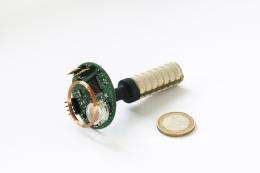Tracking down rust

(PhysOrg.com) -- Damage to concrete bridges caused by rust can have fatal consequences, at worst leading to a total collapse. Now, researchers have developed an early-warning system for rust. Sensor-transponders integrated in the concrete allow the extent of corrosion to be measured.
Concrete bridges have to be strong enough to cope with a wide variety of different impacts: frost, heavy traffic and emissions all take their toll on these structures. And then there are the various types of road salt used in winter to combat icy roads. The most common of these is sodium chloride, which is deployed in large amounts on Germany's roads. When the ice thaws, these salts break down into their ionic components that penetrate the concrete, destroying its five-centimeter thick protective alkaline layer. Any salt that leaches through to the steel rods used to reinforce the concrete pad will cause them to rust, resulting in structural damage. The result is cracks. In a worst-case scenario the bridge itself could collapse.
Until now there have been no effective tests to determine how deep the ions have penetrated the concrete and what damage they have already caused. Current practice is time-consuming and involves construction workers hammering on the reinforced concrete in search of cavities, which are a sure sign of corrosion damage. But experts at the Fraunhofer Institute for Microelectronic Circuits and Systems IMS in Duisburg, Germany, have now hit upon a more reliable and cost-effective method for detecting rust corrosion at an early stage. With a new sensor-transponder they can continuously measure and monitor how deep the ions have penetrated the concrete. While the sensor was developed by the building materials testing facility in Braunschweig (MPA Braunschweig), the integrated passive wireless transponder system is the work of IMS researchers.
The sensor itself is crisscrossed by very fine iron wires, laid down at even distances. "If the dissolved salts reach the iron wires, these begin to corrode and break. The number of defective iron wires is an indicator of the extent of corrosion and the depth to which the concrete's protective layer has been penetrated. This allows us to determine when the next repair work needs to be carried out," explains Frederic Meyer, a researcher at the IMS. The transponder transmits the measured data by wireless to the reading device carried by the construction workers. "Our transponder does not get the energy it needs to measure the corrosion from a battery, but from a magnetic field. This means it does not need to be replaced and can remain within the concrete structure permanently," says Meyer.
The first field tests are already underway, with the sensor-transponder being integrated and put through its paces in a test bridge constructed by the MPA Braunschweig. The researchers will be exhibiting a prototype at the EURO ID trade fair, to be held in Cologne, Germany, from May 4 through 6.
Provided by Fraunhofer-Gesellschaft


















